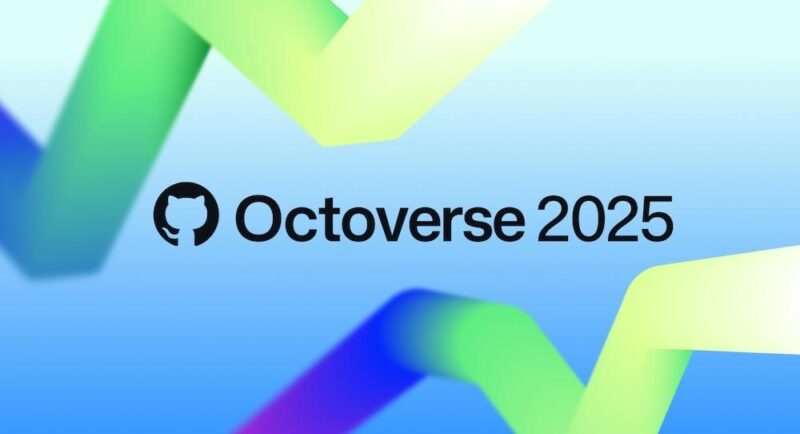Octoverse 2025 Report
GitHub
GitHub Universe 2025, held October 28-29 at the Fort Mason Center in San Francisco, showcased the latest innovations shaping the future of software development and coincided with the release of the company’s annual Octoverse report. The two-day conference brought together industry leaders, developers, and open source contributors from around the world to explore how artificial intelligence is reshaping development practices, tooling, and team workflows.
The timing of the Octoverse 2025 report release during the conference proved strategic, as it provided attendees with comprehensive data on how the developer ecosystem transformed over the preceding 12 months. The report tracks activity across GitHub’s 180 million user base and analyzes trends in programming language adoption, growth of artificial intelligence repositories, global developer distribution, and platform productivity metrics.
Here are 10 key takeaways from the report:
1) Developer Growth Accelerates at Record Pace
GitHub added 36 million new developers in 2025, bringing the total platform population to 180 million with more than one developer joining every second. Nearly 80% of new developers adopted GitHub Copilot within their first week, signaling that AI-assisted development is now a baseline expectation rather than an optional tool. This growth outpaces previous cycles and indicates structural shifts in the global developer population rather than incremental expansion.
2) TypeScript Overtakes Python as Primary Language
TypeScript became the most-used programming language on GitHub for the first time in August 2025, adding 1 million+ contributors with 66% year-over-year growth. The shift reflects practical advantages: TypeScript’s strict type system generates more reliable code when paired with AI coding assistants, reducing runtime errors and enabling safer refactoring. This represents the most significant language transition in over a decade and signals a fundamental realignment in how organizations structure application development.
3) AI Repository Growth Explodes Across the Platform
More than 1.1 million public repositories now use large language model software development kits, representing 178% year-over-year growth with 693,867 new projects launched in the past 12 months. Monthly contributors to generative AI projects increased from 68,000 in January 2024 to 200,000 by August 2025, indicating sustained momentum in AI infrastructure development. Six of the top ten fastest-growing open source projects focus on AI infrastructure, confirming that organizations are building foundational systems rather than solely experimenting with applications.
4) India Becomes Largest Open Source Contributor Base
India added 5+ million developers in 2025, representing 14% of all new global accounts and now holding the largest open source contributor base worldwide. GitHub projects 57.5 million developers in India by 2030, which would represent one in three new developers globally and fundamentally reshape talent acquisition markets. This geographic redistribution requires organizations to reconsider recruitment strategies and remote work infrastructure to access expanding talent pools outside traditional markets.
5) Platform Activity Reaches Unprecedented Levels
Developers merged 43.2 million pull requests monthly with 23% year-over-year growth, while code pushes climbed to 82.19 million compared to 65 million in 2024. The platform processed 986 million commits in 2025, a 25% year-over-year increase, indicating actual productivity gains beyond simple user growth. These activity metrics suggest organizations are shipping more features, managing larger codebases, and maintaining higher development velocity than previous years.
6) Security Vulnerability Response Times Improve Significantly
Average fix times for critical security vulnerabilities dropped 30% to 26 days from 37 days in the previous year, driven by automated remediation tools and streamlined review processes. Dependabot adoption grew 137% to 846,000 projects as teams implement automated security scanning and patch merging. GitHub Copilot Autofix addressed broken access control issues in 6,000+ repositories monthly, demonstrating that AI-assisted security remediation is keeping pace with vulnerability discovery rates.
7) Python Maintains AI Workload Dominance Despite Language Shift
Python added 850,579 contributors with 48.78% year-over-year growth and powers nearly half of all new AI repositories with 582,196 projects. Jupyter Notebooks, predominantly used with Python, appeared in 2.4 million repositories with 75% year-over-year growth, indicating continued strength in data science and machine learning contexts. This specialization pattern shows organizations are adopting TypeScript for application development while retaining Python for AI and data science workflows, creating bifurcated skill requirements.
8) Open Source Infrastructure Consolidates Around Core Languages
Nearly 80% of new repositories use one of six languages: Python, JavaScript, TypeScript, Java, C++, or C#, indicating technology stack decisions are consolidating rather than fragmenting. This concentration around established ecosystems provides organizations with lower adoption risk and access to mature tooling and talent pools. The trend suggests enterprise adoption of emerging languages will remain limited, and competitive differentiation will focus on implementation approaches rather than fundamental technology choices.
9) AI-Assisted Development Introduces New Security Challenges
Broken access control overtook injection as the most common code security alert, appearing in 151,000+ repositories with 172% year-over-year growth, often due to AI-generated scaffolds skipping authentication checks. This represents a category shift in vulnerability patterns rather than simple quantitative increase and requires security training to address new risk profiles. Organizations must implement guardrails for AI code generation and establish review processes that validate security implications, not just functional correctness.
10) Productivity Gains Realized Across Issue and Pull Request Workflows
Issue resolution climbed to 4.25 million monthly from 3.4 million year-over-year, while pull request creation increased 20.4% alongside 23% growth in merged pull requests. These metrics indicate simultaneous improvements in problem identification, solution delivery, and integration velocity, suggesting AI assistance is benefiting all development stages. Organizations measuring developer productivity should expect baseline improvements across these metrics as AI tool adoption spreads, requiring recalibration of performance benchmarks and resource allocation models.









